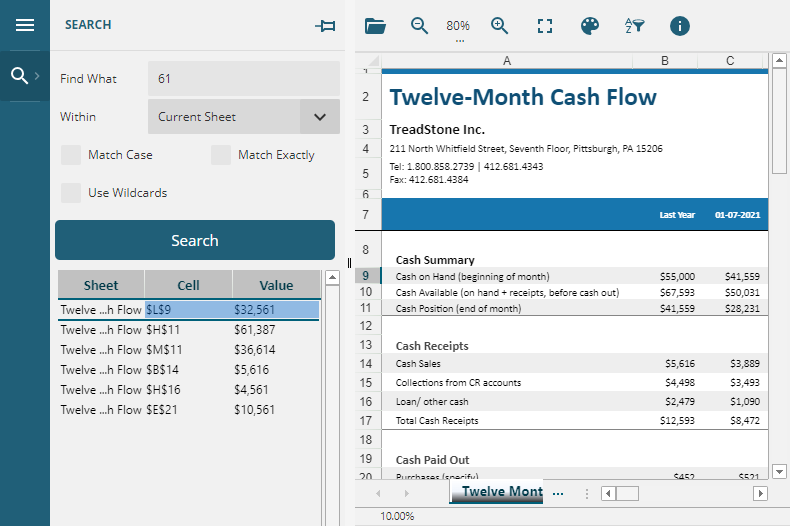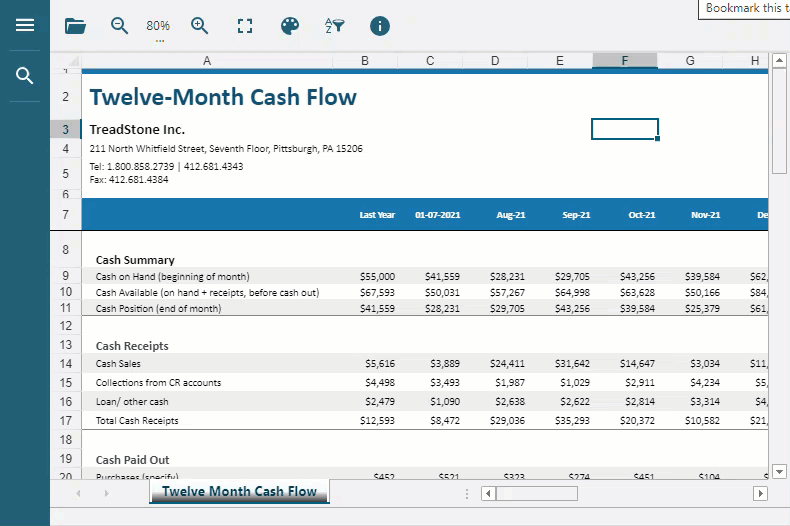- Document Solutions Data Viewer Overview
- Key Features
- Getting Started
- User Interface
- Load File
- Resize Rows and Columns
- Cell Range Selection
- Tables
- Sorting and Filtering
- Grouping and Outlines
- Data Visualization
- Scroll Bars
- Notes
- Search Data
- Extract Data
- Hyperlinks
- Keyboard Shortcuts
- Samples
- Client-side API Reference
- Release Notes
Search Data
DsDataViewer enables you to search for data in a workbook using Search Panel (![]() ) at the left-sidebar. It generates a query details table that will include sheet name, cell position, and value, allowing a user to quickly jump to the cell by clicking on the result. You can search for data in the current worksheet or across the worksheets. By default, Search Panel icon is available in the sidebar, which, when clicked, opens the sidebar with the search field and options.
) at the left-sidebar. It generates a query details table that will include sheet name, cell position, and value, allowing a user to quickly jump to the cell by clicking on the result. You can search for data in the current worksheet or across the worksheets. By default, Search Panel icon is available in the sidebar, which, when clicked, opens the sidebar with the search field and options.
Search Panel provides Find What field, Within option to choose between Current Sheet or All Sheets, and advanced options such as Match Case, Match Exactly, and Use Wildcards, which help customize the search. DsDataViewer updates the search results automatically when you update any of the advanced search options.

Search for Data
To search for data in the workbook:
Enter the value in the designated FindWhat field.
Set the Within option to Current Sheet or All Sheets.
Click on Search button to initiate the search.

Advanced Search Options
Match Case
This option finds all those instances in a workbook document that are written in the same case (lower or upper) as specified in the search query.
Example: If you search "test," the search results display "test," "tests," "testing," but not "Test."
Match Exactly
This option determines whether to perform an exact match or not.
Example: If you search "demo," the search results display "demo" and "Demo" but not "demonstration" or "demos."
Use Wildcards
This option can be used to maximize the search results. You can type a part of a word and use any number of wildcard characters with it. DsDataViewer supports the following three wildcard characters:
Asterisk (*): Use this to specify any number of characters, anywhere in the word.
Example: If you search "te*," the search results will display "tentative," "text," "extensive," and "polite."
Question Mark (?): Use this to specify a single character, zero or one time, anywhere in the word.
Example: If you search "t?e," the search results display "treat," "starter," "elaborate," and "centre."
Tilde (~) followed by ?, *, or ~: Use this to find any word or number with a question mark, asterisk, or tilde.
Example: If you search “fy91~?”, the search results will display "fy91?".
Limitation
The Search Panel will be hidden in full-screen view and thus cannot be used.


